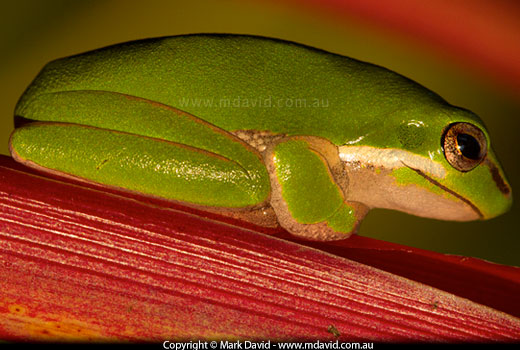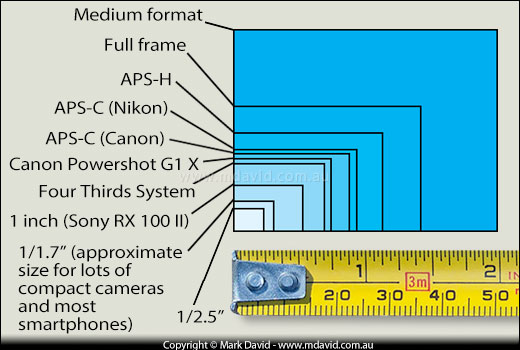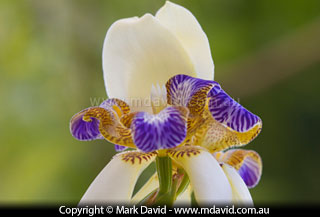
Camera manufacturers love boasting about megapixel counts. But they rarely talk much about the size of their sensors. The truth is, sensor size contributes a lot more to image quality than megapixel counts. Here’s why.

A large sensor not only works better in dim light, but it’s also better at blurring away your backgrounds. The frog’s an Eastern Dwarf Tree Frog.
The sensor in a digital camera is the thing that does the job of film in a film camera. The bigger it is, the more light can be focused onto it, giving it an advantage in weak light.
The light-capturing surface of a sensor is divided up into individual pixels, with a million of those pixels called a megapixel. Camera manufacturers love boasting about how many megapixels they’ve squeezed into their sensors and they do that to make their cameras sound fancier than they really are, in an effort to get you to dump your old camera and buy another one. But you start running into problems when you cram too many megapixels into too small a sensor, and image quality ends up suffering.
Why sensor size matters
Jam too many pixels into an already-tiny sensor and those pixels are going to end up being too tiny to capture meaningful samples of light. So some of them will make mistakes, especially in weak light where the samples of light are even worse. Those mistakes show up as noise in your photos.
That’s why compact cameras, which usually have tiny sensors and crazy-high megapixel counts, are more likely to produce noisy photos. If they had bigger sensors then they wouldn’t have that problem.
Digital SLR cameras have nice big sensors. Okay, they aren’t the biggest that money can buy, but at least they’re bigger than almost all of the compacts. That’s why they produce images with such good quality, and it’s also why they work so well in weak light (Remember? The bigger sensor can catch more light.)
Have a look at the graphic below and you’ll see a huge range of sizes in the sensors of modern digital cameras. In fact, that graphic doesn’t even show all of them. Smartphones typically have a sensor somewhere around 1/1.7" and most compact cameras use sensors of a similar size or perhaps only slightly bigger. See how much smaller they are compared with the APS-C or full-frame sensors? That’s how much of an advantage a digital SLR camera has over a typical compact.

And while you’re looking, notice one of the many strange things about this sensor stuff: you’ll see that the so-called 1-inch sensor is nowhere near as wide as an inch! They’re not actually being dishonest as much as they are using a way of achieving that one-inch measurement in a way you’d never expect. So a reasonable person might think a 1/1.7" sensor is an inch deep and 1.7 inches wide, but in fact it turns out to be much tinier than your little fingernail. As a wise man once said, who’d have thunk it?
Now, I want to stress here that not all compact cameras have tiny sensors. Some of the really good compacts have sensors that come close to, or even match the size of the digital SLRs! And good on them for doing that. In those circumstances, the camera makers are likely to be boasting about sensor size as much as they boast about the megapixels.
Resolution
Imagine that the pixels in two sensors were identical, except one of the sensors was bigger. It’s logical, then, that the bigger sensor would have more pixels in it.
Which means it can capture images with more detail/resolution than the smaller sensors, while not having any more noise in the photos. So in other words, increasing the megapixel numbers really only works best if you also increase the size of your sensor at the same time.
What about when you work in perfect (strong) light?
If you only ever take photos in strong light, like in the middle of a sunny day, then sensor size isn’t so important. That’s because those tiny sensor pixels will be probably getting enough light to do their job properly. But there’s still a problem with that. In the middle of the day, the light will often be too desaturated for good colour photography. And at the times when colours look their richest, like near sunrise/sunset, then you’re back to the problems of weak light again. You might be able to get around this by using a flash in those weak-light moments, but a flash can only throw its light so far. Nope, you keep coming back to the advantages of bigger sensors.

The size of the sensor made a big contribution to the effect of fading away the background foliage in this photo of a flower.
One more thing …
Finally, perhaps one of the biggest advantages of that larger sensor is that it’s better for blurring away distracting backgrounds. That’s because of the way you can produce a smaller depth of field with big sensors. I talk more about that in article comparing APS-C and full-frame cameras.
Good things about big sensors
- They’re better at putting the background out of focus, so you notice your subject better.
- They capture more light, so they have an advantage in dim light, which also means they …
- produce less noise in the photos.
Bad things about big sensors
- They cost more.
- They take up more room in your camera (which usually means a bigger camera to lug around, which means you might not always have your camera with you).
- They need a bigger lens to cover them, which will probably also weigh more and cost more.
A final word
Now we know that bigger pixels have an advantage over smaller pixels, does that always mean they make better photos?
The answer to that is no, not all the time. Camera manufacturers are getting better at what they do, and that’s resulting in improvements in how well they can get those little sensor pixels to perform. And cameras are also getting to be smarter at how they process their information into photos. So for example, a really small sensor pixel today will probably perform better than the same-sized sensor pixel available 10 years ago. Also, different sensor manufacturers are having different amounts of success in how well sensors perform. So it’s wrong to say that sensor size, and by association, pixel size, are the only things that matter. But it still makes a difference. A really big difference. I personally believe that a big sensor in a camera offers much more value to our photographs than a large number of megapixels.








